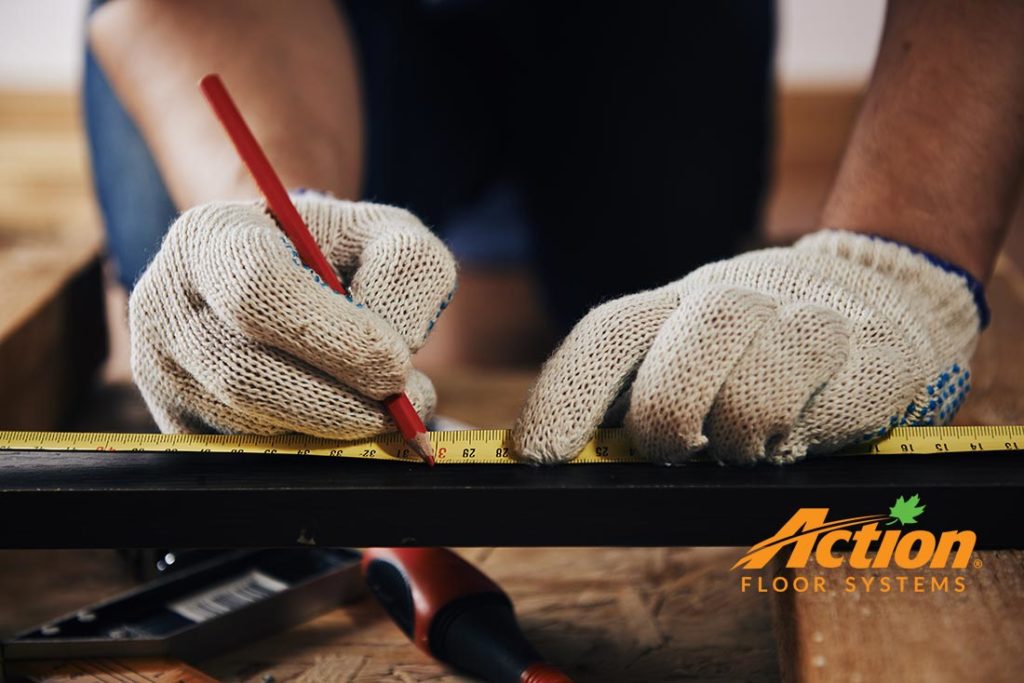
When purchasing a new maple sports floor system, there are many variables to consider. Because it can be a significant investment, understanding the attributes that directly influence the performance of the floor system, and those that use it, will help you to make a sound decision.
For maple sports floor systems, the subfloor is one of the most critical components of the floor system. Let’s take a look at how the subfloor impacts maple floor systems.
What Makes Up a Maple Sports Floor System?
You may think of a maple sports floor system as the flooring that you see in your facility’s basketball court, or the surface that supports the bleachers and tables in your university’s gymnasium. However, a sports floor system goes far beyond the finished floor.
Every floor system begins with a slab. Usually made out of concrete, this is the structural element that makes up the foundation of your floor. Having a concrete slab that meets the flatness requirements and exceeds the installation tolerance is important, as this ultimately determines the success of a new maple floor system.
Beginning with the concrete slab, each component plays an integral role in the flooring system. We spoke with our V.P. of Sales, Ron Fenhaus, about how the slab profile determines the success of the subfloor.
“The subfloor system is designed to deliver performance, comfort, and safety to the users. The subfloor system will only perform when installed on a concrete slab that meets the tolerances for installation. A slab that is not within the specified tolerance levels will impede the performance of the floor system,” says Ron.
Above the concrete slab lies the subfloor. The subfloor is very important as it is the engineered structure that acts as the support for your maple flooring. A properly installed subfloor system enhances the performance, comfort, and safety of people using the floors.
The last component in the floor system is the maple finish floor. This is the visible layer of the system that directly supports the weight of the equipment and the athletes that utilize the flooring.
Maple flooring is typically installed as an unfinished product and requires a series of sanding, using coarse, medium, and fine sandpapers. Immediately following the sanding, maple floors are sealed twice with a penetrating sealer and are finished with one to two coats of finish.
Common Material for Subfloors
As we previously mentioned, the subfloor is commonly regarded as one of the most important parts of the maple flooring system, though many athletes and other users are unfamiliar with its role.
Subfloors are manufactured from a variety of materials, from dimensional lumber, LVL (laminated veneer lumber) plywood, to strand sheathing. The subfloor material selected is often based on the type of athletic performance the floor system is expected to host.
One of the most commonly used materials is plywood. Some factory fabricated subfloor system panels are made of plywood, because of its durability and stability. The durability and stability are critical for continued use for athletic applications.
Activities Impact Subfloor Selection/Design
When it comes to sports flooring, the primary role of subfloor systems is to help enhance the athletic performance.
“The [subfloor] design determines how the overall floor system will athletically perform, which includes the floor’s level of shock absorption, how resistant the surface is when you jump on it, and how uniform the floor system feels across its entirety,” Ron says.
Subfloors used in athletic flooring systems should maintain a high level of shock absorbency, as this directly relates to the safety of a floor when being used for athletic purposes. Traction or co-efficient of friction which is a function of the finished applied to the maple flooring and overall athletic performance are also taken into consideration when designing a sports surface, so the right subfloor for one activity may not necessarily be the best fit for another.
For example, the most important feature in a sports surface used for collegiate athletics may be maximum shock absorption, as this is what helps reduce athlete injury and minimizes impact and stress to the joints and muscles of an athlete. On the other hand, a dance or yoga studio may place a high level of importance on application uniformity for its users, as an inconsistent surface could inhibit a user’s performance and potentially increase the chance of injury.
Additionally, the subfloors that are developed for specific sport applications, such as basketball courts, are often designed to deliver optimal ball bounce, also known as ball rebound. Ball bounce is the measurement of how a ball responds to being reflected on a surface.
Because the athletic performance of a flooring system means different things to different athletes and athletic directors, it’s important to invest your time in getting to know the different subfloor configurations and the benefits each design provide. Learn more about the key performance features of hardwood courts in another one of our blog posts.
Count on Action Floors® For All Your Sports Flooring Needs
Based out of Mercer, Wisconsin, our flooring specialists at Action Floors are proud to serve customers throughout the nation with all of their sports flooring needs. We offer a wide variety of customized flooring systems to meet your project’s particular needs and expectations.
To learn more about our athletic flooring systems and products, contact us today or call 800-746-3512.


















